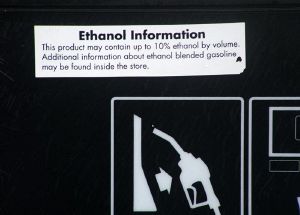Biofuel
| Renewable energy |
|---|
|
| Alternative energy |
Biofuel is defined as fuel derived from biological materials, including materials from organisms that died relatively recently and from the metabolic by-products of living organisms. They include wood, vegetable oils, animal fats, and animal manure. By contrast, fossil fuels, such as coal and petroleum, are derived from long-dead biological materials that have been transformed by geological processes.
In principle, biofuels can be obtained from any biological carbon source, but the most common sources are photosynthetic plants. A number of agricultural crops are being grown specifically for biofuel production, including corn, switchgrass, soybean, sugar beet, sugarcane, sorghum, and jatropha. They are known as agrofuels. In addition, recent technology developed at the Los Alamos National Laboratory allows for the conversion of pollution into renewable biofuel.
The use of biofuels is expanding across the globe, as they offer several advantages over fossil fuels. For example, many biofuels are nontoxic, biodegradable, and renewable. The pros and cons of biofuels are being discussed in the context of a variety of international issues, including the mitigation of carbon emissions levels and oil prices, the "food vs. fuel" debate, sustainable fuel production, deforestation and soil erosion, impact on water resources, poverty reduction potential, energy balance and efficiency, and centralized versus decentralized production.
Advantages of biofuels
Unlike most other types of fuels, many biofuels are nontoxic and biodegradable. As a result, they are relatively harmless to the environment if spilled.[1][2][3]
The use of biofuels reduces dependence on petroleum and enhances energy security.[4] Also, unlike fossil fuels, which return carbon that was stored beneath the surface for millions of years into the atmosphere, biofuels can produce energy without causing a net increase of atmospheric carbon. This is because as new plants are grown to produce fuel, they remove the same amount of carbon dioxide from the atmosphere as they will release as fuel. However, some studies have found that certain crops may produce more harmful greenhouse gases than carbon dioxide, indicating that the specific biofuel used is an important factor.
Historical highlights
Humans have used solid biofuels (such as wood and other biomass) for heating and cooking since the discovery of fire. Following the development of ways to produce electricity, it became possible to use biofuels to generate electrical power as well. However, the fluctuations of supply and demand, energy policy, military conflict, and the environmental impacts, have all contributed to a highly complex and volatile market for energy and fuel. For example, the discovery of large supplies of fossil fuels‚ÄĒcoal, natural gas, and oil‚ÄĒled to dramatic reductions in the use of biomass fuel in the developed world for transport, heat, and power. Petroleum-based fuels became inexpensive and soon were widely used to operate cars and trucks.
Before World War II, and during the high-demand wartime period, biofuels were valued as a strategic alternative to imported oil. Wartime Germany experienced extreme oil shortages and pursued many energy innovations, including the powering of some vehicles using a blend of gasoline with alcohol fermented from potatoes, called Monopolin. In Britain, grain alcohol was blended with petrol by the Distillers Company Limited under the name Discol.
After the war, inexpensive oil from the Middle East contributed in part to the lessened economic and geopolitical interest in biofuels. Then, in 1973 and 1979, geopolitical conflict in the Middle East caused OPEC to cut exports, and non-OPEC nations experienced a very large decrease in oil supply. This "energy crisis" resulted in severe shortages, and a sharp increase in the prices of oil-based products, notably gasoline. There was also increased interest from governments and academics in energy issues and biofuels.
Since the year 2000, there has been renewed interest in biofuels. The drivers for biofuel research and development include rising oil prices, concerns over the potential oil peak, greenhouse gas emissions, rural development interests, and instability in the Middle East.
Biomass
Biomass is material derived from recently living organisms. This includes materials from plants and animals and their by-products. For example, manure, garden waste and crop residues are all sources of biomass. It is a renewable energy source based on the carbon cycle, unlike other natural resources such as petroleum, coal, and nuclear fuels.
Animal waste is a persistent and unavoidable pollutant produced primarily by the animals housed in industrial-scale farms. Researchers from Washington University have figured out a way to turn manure into biomass. In April 2008, with the help of imaging technology, they noticed that vigorous mixing helps microorganisms turn farm waste into alternative energy, providing farmers with a simple way to treat their waste and convert it into energy.[5]
There are also agricultural products specifically grown for biofuel production. As noted above, these biofuels are known as agrofuels. There are two common strategies of producing agrofuels. One is to grow crops high in sugar (sugar cane, sugar beet, and sweet sorghum[6]) or starch (corn/maize), and then use yeast fermentation to produce ethyl alcohol (ethanol). The second is to grow plants that contain high amounts of vegetable oil, such as oil palm, soybean, algae, or jatropha. When these oils are heated, their viscosity is reduced, and they can be burned directly in a diesel engine, or they can be chemically processed to produce fuels such as biodiesel. Wood and its byproducts can also be converted into biofuels such as woodgas, methanol or ethanol fuel.
Currently, crops being grown for biofuels include the following: corn, switchgrass, and soybeans, primarily in the United States; rapeseed, wheat, and sugar beet, primarily in Europe; sugarcane in Brazil; palm oil and miscanthus in Southeast Asia; sorghum and cassava in China; and jatropha in India. Hemp has also been proven to work as a biofuel.
Biodegradable outputs from industry, agriculture, forestry, and households can also be used for biofuel production, either using anaerobic digestion to produce biogas, or using second generation biofuels. Examples include straw, timber, manure, rice husks, sewage, and food waste. Biomass can come from waste plant material. The use of biomass fuels can therefore contribute to waste management as well as fuel security, though alone they are not a comprehensive solution to these problems.
Energy from bio waste
Using waste biomass to produce energy can reduce the use of fossil fuels, reduce greenhouse gas emissions, and reduce pollution and waste management problems. A recent publication by the European Union highlighted the potential for waste-derived bioenergy to contribute to the reduction of global warming. The report concluded that 19 million tons of oil equivalent is available from biomass by 2020, 46 percent from bio-wastes: municipal solid waste (MSW), agricultural residues, farm waste and other biodegradable waste streams.[7]
Landfill sites generate gases as the waste buried in them undergoes anaerobic digestion. These gases are known collectively as landfill gas (LFG). This is considered a source of renewable energy, even though landfill disposal is often non-sustainable. Landfill gas can be burned either directly for heat or to generate electricity for public consumption. Landfill gas contains approximately 50 percent methane, the main component of natural gas.
If landfill gas is not harvested, it escapes into the atmosphere. This is undesirable because methane is a greenhouse gas with much more global warming potential than carbon dioxide.[8][9] Over a time span of 100 years, one ton of methane produces the same greenhouse gas (GHG) effect as 23 tons of CO2. When methane burns, it produces carbon dioxide in the ratio 1:1‚ÄĒCH4 + 2O2 = CO2 + 2H2O. So, by harvesting and burning landfill gas, its global warming potential is reduced a factor of 23, in addition to providing energy for heat and power.
It was recently discovered that living plants also produce methane.[10] The amount is 10 to 100 times greater than that produced by dead plants in an aerobic environment but does not increase global warming because of the carbon cycle.
Anaerobic digestion can be used as a waste management strategy to reduce the amount of waste sent to landfill and generate methane, or biogas. Any form of biomass can be used in anaerobic digestion and will break down to produce methane, which can be harvested and burned to generate heat, power or to power certain automotive vehicles.
A current project for a 1.6 MW landfill power plant is projected to provide power for 880 homes.[11] It is estimated that this will eliminate 3,187 tons of methane and directly eliminate 8.756 tons of carbon dioxide release per year. This is the same as removing 12,576 cars from the road, or planting 15,606 trees, or not using 359 rail cars of coal per year.
Liquid fuels for transportation
Most transportation fuels are liquids, because vehicles usually require high energy density, as occurs in liquids and solids. Vehicles usually need high power density as can be provided most inexpensively by an internal combustion engine. These engines require clean burning fuels, in order to keep the engine clean and minimize air pollution.
The fuels that are easier to burn cleanly are typically liquids and gases. Thus liquids (and gases that can be stored in liquid form) meet the requirements of being both portable and clean burning. Also, liquids and gases can be pumped, which means handling is easily mechanized, and thus less laborious.
First generation biofuels
'First-generation biofuels' are biofuels made from sugar, starch, vegetable oil, or animal fats using conventional technology.[12] The basic feedstocks for the production of first generation biofuels are often seeds or grains such as wheat, which yields starch that is fermented into bioethanol, or sunflower seeds, which are pressed to yield vegetable oil that can be used in biodiesel. These feedstocks could instead enter the animal or human food chain, and as the global population has risen their use in producing biofuels has been criticized for diverting food away from the human food chain, leading to food shortages and price increases.
The most common first generation biofuels are discussed below.
Vegetable oil
Edible vegetable oil is generally not used as fuel, but lower quality oil can be used for this purpose. Used vegetable oil is increasingly being processed into biodiesel, or (more rarely) cleaned of water and particulates and used as a fuel. To ensure that the fuel injectors atomize the fuel in the correct pattern for efficient combustion, vegetable oil fuel must be heated to reduce its viscosity to that of diesel, either by electric coils or heat exchangers. This is easier in warm or temperate climates. MAN B&W Diesel, Wartsila and Deutz AG offer engines that are compatible with straight vegetable oil, without the need for after-market modifications. Vegetable oil can also be used in many older diesel engines that do not use common rail or unit injection electronic diesel injection systems. Due to the design of the combustion chambers in indirect injection engines, these are the best engines for use with vegetable oil. This system allows the relatively larger oil molecules more time to burn. However, a handful of drivers have experienced limited success with earlier pre- "pumpe duse" VW TDI engines and other similar engines with direct injection.
Biodiesel
Biodiesel is the most common biofuel in Europe. It is produced from oils or fats using transesterification and is a liquid similar in composition to fossil/mineral diesel. Its chemical name is fatty acid methyl (or ethyl) ester (FAME). Oils are mixed with sodium hydroxide and methanol (or ethanol) and the chemical reaction produces biodiesel (FAME) and glycerol. One part glycerol is produced for every ten parts biodiesel. Feedstocks for biodiesel include animal fats, vegetable oils, soy, rapeseed, jatropha, mahua, mustard, flax, sunflower, palm oil, hemp, field pennycress, and algae. Pure biodiesel (B100) is by far the lowest emission diesel fuel. Although liquefied petroleum gas and hydrogen have cleaner combustion, they are used to fuel much less efficient petrol engines and are not as widely available.
Biodiesel can be used in any diesel engine when mixed with mineral diesel. The majority of vehicle manufacturers limit their recommendations to 15% biodiesel blended with mineral diesel. In some countries manufacturers cover their diesel engines under warranty for B100 use, although Volkswagen of Germany, for example, asks drivers to check by telephone with the VW environmental services department before switching to B100. B100 may become more viscous at lower temperatures, depending on the feedstock used, requiring vehicles to have fuel line heaters. In most cases, biodiesel is compatible with diesel engines from 1994 onwards, which use 'Viton' (by DuPont) synthetic rubber in their mechanical injection systems. Electronically controlled 'common rail' and 'pump duse' type systems from the late 1990s onwards may only use biodiesel blended with conventional diesel fuel. These engines have finely metered and atomized multi-stage injection systems are very sensitive to the viscosity of the fuel. Many current generation diesel engines are made so that they can run on B100 without altering the engine itself, although this depends on the fuel rail design. NExBTL is suitable for all diesel engines in the world since it overperforms DIN EN 590 standards.
Since biodiesel is an effective solvent and cleans residues deposited by mineral diesel, engine filters may need to be replaced more often, as the biofuel dissolves old deposits in the fuel tank and pipes. It also effectively cleans the engine combustion chamber of carbon deposits, helping to maintain efficiency. In many European countries, a 5 percent biodiesel blend is widely used and is available at thousands of gas stations.[13][14] Biodiesel is also an oxygenated fuel, meaning that it contains a reduced amount of carbon and higher hydrogen and oxygen content than fossil diesel. This improves the combustion of fossil diesel and reduces the particulate emissions from un-burnt carbon.
In the USA, more than 80 percent of commercial trucks and city buses run on diesel. The emerging US biodiesel market is estimated to have grown 200 percent from 2004 to 2005. "By the end of 2006 biodiesel production was estimated to increase fourfold [from 2004] to more than 1 billion gallons,".[15]
Bioalcohols
Biologically produced alcohols‚ÄĒmost commonly ethanol, and less commonly propanol and butanol‚ÄĒare produced by the action of microorganisms and enzymes through the fermentation of sugars or starches (easiest), or cellulose (which is more difficult). Biobutanol (also called biogasoline) is often claimed to provide a direct replacement for gasoline, because it can be used directly in a gasoline engine (in a similar way to biodiesel in diesel engines).
Butanol is formed by ABE fermentation (acetone, butanol, ethanol) and experimental modifications of the process show potentially high net energy gains with butanol as the only liquid product. Butanol will produce more energy and allegedly can be burned "straight" in existing gasoline engines (without modification to the engine or car),[16] and is less corrosive and less water soluble than ethanol, and could be distributed via existing infrastructures. DuPont and BP are working together to help develop butanol.
Ethanol fuel is the most common biofuel worldwide, particularly in Brazil. Alcohol fuels are produced by fermentation of sugars derived from wheat, corn, sugar beets, sugar cane, molasses and any sugar or starch that alcoholic beverages can be made from (like potato and fruit waste, etc.). The ethanol production methods used are enzyme digestion (to release sugars from stored starches, fermentation of the sugars, distillation and drying. The distillation process requires significant energy input for heat (often unsustainable natural gas fossil fuel, but cellulosic biomass such as bagasse, the waste left after sugar cane is pressed to extract its juice, can also be used more sustainably).
Ethanol can be used in petrol engines as a replacement for gasoline; it can be mixed with gasoline to any percentage. Most existing automobile petrol engines can run on blends of up to 15 percent bioethanol with petroleum/gasoline. Gasoline with ethanol added has higher octane, which means that your engine can typically burn hotter and more efficiently. In high altitude (thin air) locations, some states mandate a mix of gasoline and ethanol as a winter oxidizer to reduce atmospheric pollution emissions.
Ethanol fuel has less BTU energy content, which means it takes more fuel (volume and mass) to produce the same amount of work. An advantage of ethanol is that is has a higher octane rating than ethanol-free gasoline available at roadside gas stations and ethanol's higher octane rating allows an increase of an engine's compression ratio for increased thermal efficiency. Very-expensive aviation gasoline (Avgas) is 100 octane made from 100 percent petroleum with toxic tetra-ethyl lead added to raise the octane number. The high price of zero-ethanol Avgas does not include federal-and-state road-use taxes.
Ethanol is very corrosive to fuel systems, rubber hoses and gaskets, aluminum, and combustion chambers. Therefore, it is illegal to use fuels containing alcohol in aircraft (although at least one model of ethanol-powered aircraft has been developed, the Embraer EMB 202 Ipanema). Ethanol also corrodes fiberglass fuel tanks such as used in marine engines. For higher ethanol percentage blends, and 100 percent ethanol vehicles, engine modifications are required.
It is the hygroscopic (water loving) nature of relatively polar ethanol that can promote corrosion of existing pipelines and older fuel delivery systems. To characterize ethanol itself as a corrosive chemical is somewhat misleading and the context in which it can be indirectly corrosive is somewhat narrow (that is, limited to effects upon existing pipelines designed for petroleum transport.
Corrosive ethanol cannot be transported in petroleum pipelines, so more-expensive over-the-road stainless-steel tank trucks increase the cost and energy consumption required to deliver ethanol to the customer at the pump.
In the current alcohol-from-corn production model in the United States, considering the total energy consumed by farm equipment, cultivation, planting, fertilizers, pesticides, herbicides, and fungicides made from petroleum, irrigation systems, harvesting, transport of feedstock to processing plants, fermentation, distillation, drying, transport to fuel terminals and retail pumps, and lower ethanol fuel energy content, the net energy content value added and delivered to consumers is very small. Also, the net benefit (all things considered) does little to reduce un-sustainable imported oil and fossil fuels required to produce the ethanol.[17]
Although ethanol-from-corn and other food stocks has implications both in terms of world food prices and limited, yet positive energy yield (in terms of energy delivered to customer/fossil fuels used), the technology has lead to the development of cellulosic ethanol. According to a joint research agenda conducted through the U.S. Department of Energy, the fossil energy ratios (FER) for cellulosic ethanol, corn ethanol, and gasoline are 10.3, 1.36, and 0.81, respectively.[18][19][20]
Many car manufacturers are now producing flexible-fuel vehicles (FFV's), which can safely run on any combination of bioethanol and petrol, up to 100 percent bioethanol. They dynamically sense exhaust oxygen content, and adjust the engine's computer systems, spark, and fuel injection accordingly. This adds initial cost and ongoing increased vehicle maintenance. Efficiency falls and pollution emissions increase when FFV system maintenance is needed (regardless of the fuel mix being used), but not performed (as with all vehicles). FFV internal combustion engines are becoming increasingly complex, as are multiple-propulsion-system FFV hybrid vehicles, which impacts cost, maintenance, reliability, and useful lifetime longevity.
Alcohol mixes with both petroleum and with water, so ethanol fuels are often diluted after the drying process by absorbing environmental moisture from the atmosphere. Water in alcohol-mix fuels reduces efficiency, makes engines harder to start, causes intermittent operation (sputtering), and oxidizes aluminum (carburetors) and steel components (rust).
Even dry ethanol has roughly one-third lower energy content per unit of volume compared to gasoline, so larger / heavier fuel tanks are required to travel the same distance, or more fuel stops are required. With large current un-sustainable, non-scalable subsidies, ethanol fuel still costs much more per distance traveled than current high gasoline prices in the United States.[21]
Methanol is currently produced from natural gas, a non-renewable fossil fuel. It can also be produced from biomass as biomethanol. The methanol economy is an interesting alternative to the hydrogen economy, compared to today's hydrogen produced from natural gas, but not hydrogen production directly from water and state-of-the-art clean solar thermal energy processes.[22]
Biogas
Biogas is produced by the process of anaerobic digestion of organic material by anaerobes. It can be produced either from biodegradable waste materials or by the use of energy crops fed into anaerobic digesters to supplement gas yields. The solid byproduct, digestate, can be used as a biofuel or a fertilizer. In the UK, the National Coal Board experimented with microorganisms that digested coal in situ converting it directly to gases such as methane.
Biogas contains methane and can be recovered from industrial anaerobic digesters and mechanical biological treatment systems. Landfill gas is a less clean form of biogas which is produced in landfills through naturally occurring anaerobic digestion. If it escapes into the atmosphere it is a potent greenhouse gas.
Oils and gases can be produced from various biological wastes:
- Thermal depolymerization of waste can extract methane and other oils similar to petroleum.
- GreenFuel Technologies Corporation developed a patented bioreactor system that uses nontoxic photosynthetic algae to take in smokestacks flue gases and produce biofuels such as biodiesel, biogas and a dry fuel comparable to coal.[23]
Syngas
Syngas is produced by the combined processes of pyrolysis, combustion, and gasification. Biofuel is converted into carbon monoxide and energy by pyrolysis. A limited supply of oxygen is introduced to support combustion. Gasification converts further organic material to hydrogen and additional carbon monoxide.
The resulting gas mixture, syngas, is itself a fuel. Using the syngas is more efficient than direct combustion of the original biofuel; more of the energy contained in the fuel is extracted.
Syngas may be burned directly in internal combustion engines. The wood gas generator is a wood-fueled gasification reactor mounted on an internal combustion engine. Syngas can be used to produce methanol and hydrogen, or converted via the Fischer-Tropsch process to produce a synthetic petroleum substitute. Gasification normally relies on temperatures >700¬įC. Lower temperature gasification is desirable when co-producing biochar.
Solid biofuels
Examples of solid biofuels include wood, sawdust, grass cuttings, domestic refuse, charcoal, agricultural waste, non-food energy crops (see picture), and dried manure.
When raw biomass is already in a suitable form (such as firewood), it can burn directly in a stove or furnace to provide heat or raise steam. When raw biomass is in an inconvenient form (such as sawdust, wood chips, grass, agricultural wastes), another option is to pelletize the biomass with a pellet mill. The resulting fuel pellets are easier to burn in a pellet stove.
Second generation biofuels
Supporters of biofuels claim that a more viable solution is to increase political and industrial support for, and rapidity of, second-generation biofuel implementation from non food crops, including cellulosic biofuels. Second-generation biofuel production processes can use a variety of non food crops. These include waste biomass, the stalks of wheat, corn, wood, and special-energy-or-biomass crops (e.g. Miscanthus). Second generation (2G) biofuels use biomass to liquid technology, including cellulosic biofuels from non food crops. Many second generation biofuels are under development such as biohydrogen, biomethanol, DMF, Bio-DME, Fischer-Tropsch diesel, biohydrogen diesel, mixed alcohols and wood diesel.
Cellulosic ethanol production uses non food crops or inedible waste products and does not divert food away from the animal or human food chain. Lignocellulose is the "woody" structural material of plants. This feedstock is abundant and diverse, and in some cases (like citrus peels or sawdust) it is a significant disposal problem.
Producing ethanol from cellulose is a difficult technical problem to solve. In nature, ruminant livestock (like cattle) eats grass and then use slow enzymatic digestive processes to break it into glucose (sugar). In cellulosic ethanol laboratories, various experimental processes are being developed to do the same thing, and then the sugars released can be fermented to make ethanol fuel.
The recent discovery of the fungus Gliocladium roseum points toward the production of so-called myco-diesel from cellulose. This organism was recently discovered in the rainforests of northern Patagonia and has the unique capability of converting cellulose into medium-length hydrocarbons typically found in diesel fuel.[24]
Scientists are also working on experimental recombinant DNA genetic engineering organisms that can increase biofuel potential.
Third generation biofuels
Algae fuel, also called oilgae or third generation biofuel, is a biofuel from algae. Algae are low-input, high-yield feedstocks to produce biofuels. It produces 30 times more energy per acre than land crops such as soybeans.[25] With the higher prices of fossil fuels (petroleum), there is much interest in algaculture (farming algae).
The United States Department of Energy estimates that if algae fuel replaced all the petroleum fuel in the United States, it would require 15,000 square miles (38,849 square kilometers), which is roughly the size of Maryland.[25]
Second and third generation biofuels are also called advanced biofuels.
Fourth generation biofuels
An appealing fourth generation biofuel is based on the conversion of vegoil and biodiesel into gasoline. [26]
Craig Venter's company Synthetic Genomics is genetically engineering microorganisms to produce fuel directly from carbon dioxide on an industrial scale.[27]
Biofuels by region
Recognizing the importance of implementing bioenergy, there are international organizations such as IEA Bioenergy,[28] established in 1978 by the OECD International Energy Agency (IEA), with the aim of improving cooperation and information exchange between countries that have national programs in bioenergy research, development and deployment. The U.N. International Biofuels Forum is formed by Brazil, China, India, South Africa, the United States and the European Commission.[29] The world leaders in biofuel development and use are Brazil, United States, France, Sweden and Germany.
See also
- Automobile
- Biomass
- Carbon cycle
- Coal
- Corn
- Ethanol
- Fossil fuel
- Hybrid vehicle
- Natural gas
- Petroleum
- Photosynthesis
Notes
- ‚ÜĎ "Green Dream" Backed by MPS., Eastern Daily Press, (January 2003) Globeco biodegradable bio-diesel. Retrieved December 13, 2008.
- ‚ÜĎ Ethenol facts. Australian Friends of Ethanol. Retrieved December 13, 2008.
- ‚ÜĎ Low Cost Algae Production System Introduced. Energy Arizona. Retrieved December 13, 2008.
- ‚ÜĎ SmartWay Grow & Go. EPA. Retrieved December 13, 2008.
- ‚ÜĎ Christopher Leonard, Associated Press, 4/17/2008, New study advances method to make energy from farm waste. USA Today. Retrieved December 13, 2008.
- ‚ÜĎ ICRISAT: Sweet sorghum balances food and fuel needs. energycurrent.com. Retrieved December 13, 2008.
- ‚ÜĎ European Environment Agency. 2006. How much bioenergy can Europe produce without harming the environment? EEA Report no. 7.
- ‚ÜĎ IPCC Third Assessment Report. UNEP. Retrieved December 13, 2008.
- ‚ÜĎ Non-CO2 Gases Economic Analysis and Inventory: Global Warming Potentials and Atmospheric Lifetimes. EPA. Retrieved December 13, 2008.
- ‚ÜĎ Frank Keppler, John T. G. Hamilton, Marc Bra, and Thomas R√∂ckmann. 2006. Methane emissions from terrestrial plants under aerobic conditions. Nature 439:187‚Äď191.
- ‚ÜĎ Marla Toncray, 2008. Construction of landfill power plant has begun. The Ledger Independent. Retrieved December 13, 2008.
- ‚ÜĎ UN biofuels report. ESA.United Nations. Retrieved December 13, 2008.
- ‚ÜĎ ADM Biodiesel: Hamburg, Leer, Mainz. biodiesel.de. Retrieved December 13, 2008.
- ‚ÜĎ Welcome to Biodiesel Filling Stations. Biodiesel Filling Stations, UK. Retrieved December 13, 2008.
- ‚ÜĎ Will Thurmond, Biodiesel poised for "explosive" growth in the next ten years, futurist forecasts. Futurist (magazine), 41 (4)(July-August 2007) Retrieved December 13, 2008.
- ‚ÜĎ Main Page. Butyl Fuel, LLC. Retrieved December 13, 2008.
- ‚ÜĎ Andrew Bounds, September 10, 2007. OECD warns against biofuels subsidies. Financial Times. Retrieved December 13, 2008.
- ‚ÜĎ N. Brinkman, et al. 2005. Well-to-Wheels Analysis of Advanced/Vehicle Systems.
- ‚ÜĎ A.E. Farrell, et al. 2006. Ethanol can Contribute to Energy and Environmental Goals. Science 311:506-508.
- ‚ÜĎ R. Hammerschlag, 2006. Ethanol's Energy Return on Investment: A Survey of the Literature 1999-Present. Environ. Sci. Technol. 40:1744-1750.
- ‚ÜĎ With only 2/3 the energy of gasoline, ethanol costs more per mile. zFacts.com. Retrieved December 13, 2008.
- ‚ÜĎ Home Page. Hydrogen Solar. Retrieved December 13, 2008.
- ‚ÜĎ greenfuelonline.com. Green Fuel Online. Retrieved December 13, 2008.
- ‚ÜĎ Fill her up please, and make it myco-diesel. AFP, Nov 4, 2008. Retrieved December 13, 2008.
- ‚ÜĎ 25.0 25.1 Eviana Hartman, January 3, 2008. A Promising Oil Alternative: Algae Energy. Washington Post. Retrieved December 13, 2008.
- ‚ÜĎ Got some biodiesel you can't use? Convert it to gasoline with Biolene. AutoblogGreen. Retrieved December 13, 2008.
- ‚ÜĎ Craig Venter: On the verge of creating synthetic life. TED Talk. Retrieved December 13, 2008.
- ‚ÜĎ What is IEA Bioenergy? IEA bioenergy. Retrieved December 13, 2008.
- ‚ÜĎ Press Conference Launching International Biofuels Forum. United Nations Department of Public Information. Retrieved December 13, 2008.
ReferencesISBN links support NWE through referral fees
- Drapcho, Caye, Nhuan Ph√ļ Nghi√™m, and Terry Walker. Biofuels Engineering Process Technology. New York, NY: McGraw-Hill, 2008. ISBN 0071487492
- Farrell, A.E. et al. "Ethanol can Contribute to Energy and Environmental Goals." Science 311 (2006):506-508.
- Hammerschlag, R. "Ethanol's Energy Return on Investment: A Survey of the Literature 1999-Present." Environ. Sci. Technol. 40 (2006): 1744-1750.
- Mousdale, David M. Biofuels: Biotechnology, Chemistry, and Sustainable Development. Boca Raton, FL: CRC Press, 2008. ISBN 1420051245
- Nag, Ahindra. Biofuels Refining and Performance. New York, NY: McGraw-Hill, 2007. ISBN 0071489703
| |||||||||||||||||||
| |||||||||||
| |||||||||||||||||||||||||||||||||||||||||||||||
Credits
New World Encyclopedia writers and editors rewrote and completed the Wikipedia article in accordance with New World Encyclopedia standards. This article abides by terms of the Creative Commons CC-by-sa 3.0 License (CC-by-sa), which may be used and disseminated with proper attribution. Credit is due under the terms of this license that can reference both the New World Encyclopedia contributors and the selfless volunteer contributors of the Wikimedia Foundation. To cite this article click here for a list of acceptable citing formats.The history of earlier contributions by wikipedians is accessible to researchers here:
The history of this article since it was imported to New World Encyclopedia:
Note: Some restrictions may apply to use of individual images which are separately licensed.






